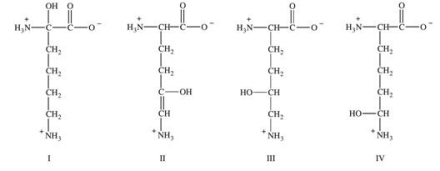A) It is a tripeptide.
B) Its primary structure is Gly-Pro-Ser.
C) There are two peptide bonds.
D) The carboxyl group of Pro is joined to the amino group of Ser.
E) The peptide contains only hydrophobic amino acid residues.
Correct Answer

verified
Correct Answer
verified
Multiple Choice
The formation of a peptide bond is best described as which of the following?
A) neutralization reaction
B) dehydration reaction
C) hydration reaction
D) hydrogenation reaction
E) oxidation reaction
Correct Answer

verified
Correct Answer
verified
Multiple Choice
What is meant by the "tertiary structure" of a protein?
A) It refers to the peptide bonds that join the amino acids together in the protein chain.
B) It describes the unique sequence of amino acids in the protein chain.
C) It describes the regular, repeating structures found in the protein chain.
D) It describes the overall three dimensional shape of a protein.
E) It describes the association of two or more polypeptide chains to form one functioning protein unit.
Correct Answer

verified
Correct Answer
verified
Multiple Choice
Which amino acid has a methyl group as its R group?
A) glycine
B) alanine
C) lysine
D) valine
E) tyrosine
Correct Answer

verified
Correct Answer
verified
Multiple Choice
Which of the following kinds of proteins are biochemical catalysts?
A) nutrient proteins
B) hormones
C) transport proteins
D) enzymes
E) antigens
Correct Answer

verified
Correct Answer
verified
Multiple Choice
What term describes the type of β-pleated sheet in which both peptides are aligned from amino terminus to carboxy terminus?
A) antiparallel
B) perpendicular
C) parallel
D) matched
E) congruent
Correct Answer

verified
Correct Answer
verified
Multiple Choice
Consider the following forms of the amino acid alanine (Ala) .Which statement concerning these structures is FALSE? 
A) Structure I represents the form of Ala present in the blood at physiological pH.
B) Structure II represents the form of Ala present in the basic environment of the intestines.
C) Structure III represents the form of Ala present in the acidic environment of the stomach.
D) Structure IV represents the zwitterion of Ala.
E) None of the statements are false.
Correct Answer

verified
Correct Answer
verified
Multiple Choice
Which of the following pairs of elements are present in proteins, but not in most carbohydrates?
A) nitrogen and sulfur
B) carbon and hydrogen
C) carbon and oxygen
D) sulfur and oxygen
E) nitrogen and oxygen
Correct Answer

verified
Correct Answer
verified
Multiple Choice
Which amino acid contains an aromatic ring in its side chain?
A) alanine
B) glycine
C) isoleucine
D) tyrosine
E) threonine
Correct Answer

verified
Correct Answer
verified
Multiple Choice
Which hydrophobic amino acid contains a sulfur atom in its side chain?
A) alanine
B) valine
C) phenylalanine
D) proline
E) methionine
Correct Answer

verified
Correct Answer
verified
Multiple Choice
Which of the following is a source of complete protein?
A) beans
B) rice
C) peanuts
D) wheat
E) chicken
Correct Answer

verified
Correct Answer
verified
Multiple Choice
Denaturation of a protein results in the loss of its native conformation and its biological activity.Which of the following best describes what happens when a protein is denatured?
A) The primary structure of the protein is altered.
B) Peptide bonds are broken, and individual amino acids are released.
C) Secondary, tertiary, or quaternary levels of structure are disrupted.
D) The N-terminal and C-terminal ends of the protein form their zwitterions.
E) The N-terminal and C-terminal ends of the protein are hydrolyzed.
Correct Answer

verified
Correct Answer
verified
Multiple Choice
The amino acid 5-hydroxylysine is found in collagen.Which of the following represents the structure of this unusual amino acid? 
A) I
B) II
C) III
D) IV
E) None of the structures represent 5-hydroxylysine.
Correct Answer

verified
Correct Answer
verified
True/False
Glycoproteins are often found as receptors on the surface of cells.
Correct Answer

verified
Correct Answer
verified
Multiple Choice
In the α-helical structure of proteins, how many amino acid residues are there in one complete full turn of the helix?
A) 2
B) 3.6
C) 4
D) 6
E) greater than 10
Correct Answer

verified
Correct Answer
verified
Multiple Choice
What is meant by the "quaternary structure" of a protein?
A) It refers to the four atoms that make up the peptide bonds that join the amino acids together in the protein chain.
B) It describes the unique sequence of four amino acids in the protein chain.
C) It describes the four regular, repeating structures found in the protein chain.
D) It describes the overall three dimensional shape of a protein.
E) It describes the association of two or more polypeptide chains to form one functioning protein unit.
Correct Answer

verified
Correct Answer
verified
Multiple Choice
Proteins are long chains of amino acids joined together by peptide bonds.Which of the following properly depicts the peptide bond formed between two generic amino acids?
A) ![]()
B) ![]()
C) ![]()
D) ![]()
E) ![]()
Correct Answer

verified
Correct Answer
verified
Multiple Choice
Blood proteins will become denatured when they develop an overall negative charge.This would be the result of which of the following?
A) a lowering of pH
B) an increase in pH
C) a lowering of the partial pressure of oxygen
D) an increase in the partial pressure of oxygen
E) poor circulation
Correct Answer

verified
Correct Answer
verified
Multiple Choice
Which of the following are proteins produced by the immune system in response to foreign substances in the body?
A) transferases
B) immunoglobulins
C) insulins
D) albumins
E) myoglobins
Correct Answer

verified
Correct Answer
verified
Multiple Choice
What level of protein structure specifies the sequence of amino acids in the protein?
A) quaternary
B) β-pleated sheet
C) primary
D) secondary
E) tertiary
Correct Answer

verified
Correct Answer
verified
Showing 41 - 60 of 73
Related Exams